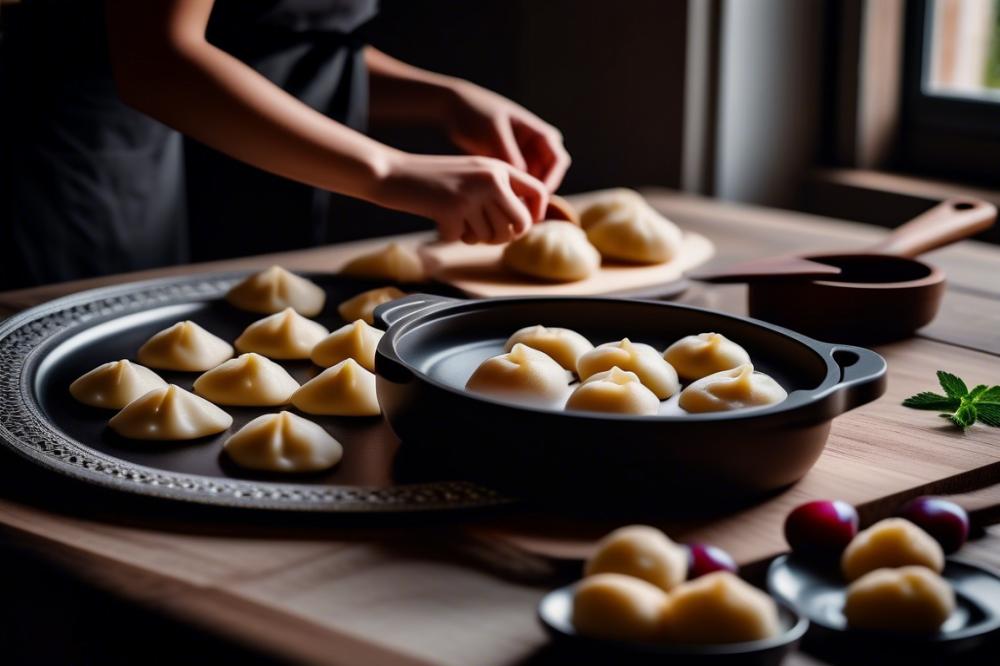Introduction
Culinary adventure holidays in Poland offer a vibrant way to explore the country’s rich traditions. Travelers eagerly participate in hands-on cooking workshops that highlight local flavors and techniques. These experiences immerse participants in the essence of Polish cuisine. Visitors discover not just recipes but the stories and cultural nuances behind each dish.
One standout delight in Eastern European dishes is the sweet, fruit-filled dumplings that many crave. These dumplings, made with a tender dough, often include a luscious plum filling. This treat is better known as Knedle. In Poland, plum dumplings hold a special place throughout summer, often served as delectable desserts. They symbolize comfort and family gatherings, making them significant in Polish culinary heritage.
Hands-on cooking experiences are vital for grasping traditional recipes. Learning how to create these delightful dumplings brings a sense of accomplishment. Engaging with local ingredients fosters appreciation, transforming mere visitors into passionate cooks. Many find joy in preparing recipes that have been passed down through generations. These workshops provide a unique blend of education and fun, ensuring that culinary skills are developed alongside cherished memories.
Understanding Polish plum dumplings
Polish plum dumplings, also known as Knedle, are a delightful treat in Eastern European cuisine. They consist of a sweet dough filled with ripe plums, creating a mouthwatering dessert that highlights fresh summer fruit. Traditionally, these dumplings are enjoyed as a sweet meal or dessert, especially during summer when plums are at their peak.
Ingredients Commonly Used
The filling usually features simple yet delicious ingredients. Ripe plums are the stars of this dish, often sprinkled with sugar and sometimes cinnamon to enhance their flavor. As for the dough, potatoes are often a key element, providing a soft texture. Flour, eggs, and a pinch of salt round out the mixture. The balance of these ingredients is crucial for achieving that perfect bite.
Variations of Dumplings in Polish cuisine
Polish cuisine offers many variations of dumplings. While plum-filled ones are popular, other fruits like cherries, strawberries, or even blueberries can be used. Each version brings its own charm to the table, showcasing the versatility of fruit dumplings. Some families may have their unique recipes that include different spices or toppings, like sour cream or breadcrumbs, which adds a new layer of flavor. Exploring these variations during a cooking workshop can be a fun experience. In essence, sweet dumplings come in many forms and flavors, making them a beloved staple.
The Art of Making Dough
Creating the perfect dough for dumplings is both an art and a science. Start with the right ingredients. Begin with flour, eggs, and a pinch of salt. Combine these to form a basic dough. Use all-purpose flour for a good texture. This flour helps achieve a balance between softness and strength.
Next, add water little by little. This helps in forming a smooth texture. Mix until the dough pulls away from the bowl. The consistency should be pliable and slightly sticky. When you knead the dough, it helps develop gluten, which is essential for elasticity. Make sure to knead for at least 5 to 10 minutes.
Tips for Achieving the Right Consistency and Texture
Focus on the feel of the dough. It should be smooth and elastic after kneading. If it’s too dry, add a bit more water. On the other hand, if it feels overly sticky, sprinkle in a touch more flour. Finding that sweet spot is key for delicious sweet dumplings.
Let the dough rest for about 20-30 minutes. This rest period allows the gluten to relax. Relaxed gluten means easier rolling. Cover the dough with a damp cloth to keep it from drying out. When you return, it should be ready for shaping.
Common Mistakes to Avoid When Making Dough for Sweet Dumplings
Beginning chefs often overlook the importance of temperature. Cold ingredients can lead to tough dough. Always ensure your eggs and water are at room temperature. Another common error is not kneading enough. Insufficient kneading results in dumplings that fall apart. Focus on working the dough until it has a consistent texture.
Watch out for using too much flour while rolling. This can make the dumplings dense and heavy. Instead, dust your surface lightly to maintain a fluffy end product. Lastly, don’t rush the resting stage. Allowing the dough to rest helps improve flavor. Following these simple guidelines makes all the difference in producing delightful fruit dumplings.
Preparing the Plum Filling
Selection of the Best Plums for Filling
Choosing the right plums is crucial. Look for ripe ones that are firm yet slightly soft. The best varieties are often the yellow and purple plums. Fresh and juicy plums yield the best results in your filling. Don’t settle for any old plums from the store. Check the skin for blemishes and avoid those that seem overripe. The flavors from quality fruit will shine through in the dumplings.
How to Prepare the Plum Filling
Start by washing the plums thoroughly. Cut them in half and remove the pits. Now, you can decide on your cooking method. You might choose to cook them on the stove or bake them. Boiling the plums with a touch of water helps soften them. If you prefer a slower method, roasting will develop a deeper flavor. Consider adding a sprinkle of sugar while cooking, depending on the plums’ sweetness. This enhances the natural taste and gives your fruit dumplings a lovely glaze.
Balancing Sweetness and Tartness in the Filling
Many traditional recipes call for balancing flavors. If your plums are sweet, a bit of lemon juice can add the needed tartness. Alternatively, use a dash of cinnamon for warmth without overpowering. This mixture creates an appealing filling for your sweet dumplings. Sample the plum mixture as you prepare. Adjustments during this stage lead to the perfect blend of flavors. Remember, it’s all about personal taste. Each person’s preference can vary widely, especially in Eastern European dishes like this one. Striking the right balance will make the dumplings a hit.
Cooking Workshop Experience
Overview of a typical knedle workshop
A knedle workshop often feels like stepping into a cozy kitchen filled with delightful aromas. Participants gather around a large table, ready to transform simple ingredients into delicious dumplings. The atmosphere buzzes with excitement and a pinch of nervousness. Most workshops last a few hours, offering ample time to learn and taste. Everyone receives hands-on experience while working with traditional recipes that have been passed down through generations.
What participants can expect during the cooking session
Attendees should be prepared for a mix of instruction and creativity. First, they will learn how to make the dough, which is the heart of these sweet dumplings. After that, it’s time to mix and prepare the plum filling. Each person gets the chance to shape their own fruit dumplings, ensuring personal touches and flavors. Expect laughter and occasional spills; it’s all part of the fun! Participants will enjoy tasting their creations as they go along, making this a delicious way to learn.
The role of local chefs in teaching traditional techniques
Local chefs play a crucial role in these workshops. They guide each step with passion and expertise. Sharing stories of their own families’ kitchen traditions adds depth to the experience. Their tips on perfecting the dough and cooking method make a real difference. Learning from seasoned cooks can inspire creativity and confidence in preparing Eastern European dishes. This connection to the community enriches the whole cooking experience. Participants leave not just with skills but also with valuable memories tied to Polish cuisine.
Serving and Enjoying Polish Plum Dumplings
Popular Ways to Serve and Garnish Dumplings
Serving dumplings can be fun and creative. Dusting them with powdered sugar adds a sweet touch. Another option is to sprinkle fresh herbs, like mint or parsley, for a pop of color. A dollop of sour cream can balance sweetness and provide a creamy contrast. Chopped nuts, such as walnuts or almonds, offer a pleasing crunch. These garnishes bring out the flavors of the plum filling and make every bite special.
Pairing Dumplings with Traditional Sauces and Toppings
Traditional recipes often include sauces that enhance dumpling enjoyment. Serve them with a warm vanilla sauce for added richness. A berry compote can brighten the dish with its tartness. Lemon-infused cream is another delightful choice that complements the sweet dumplings. Even a simple drizzle of honey can elevate the flavor profile. Creating a blend of sauces and toppings brings variety to the dining experience.
Integrating Dumplings into Summer Desserts
Fruit dumplings don’t have to be just a main dish. They can shine as summer desserts as well. Consider pairing them with a scoop of ice cream for a refreshing treat. Summertime is perfect for serving these tasty gems alongside whipped cream or fresh fruit. A fruit salad made with berries, peaches, and citrus adds a bright, zesty note. Using the delicate dough to wrap seasonal fruits is a great way to celebrate the flavors of summer. Such variations keep your meals exciting and flavorful.
Cooking as a Cultural Bridge
Reflecting on the joy of cooking Polish dumplings, we see how essential it is to connect with traditions. These delightful foods represent more than just a meal; they hold stories of family gatherings and celebrations. Learning to prepare them can bring a taste of Poland right to your kitchen, enhancing your culinary skills.
Going beyond the kitchen, consider the thrill of cultural adventure holidays in Poland. Visiting this beautiful country opens doors to explore its rich heritage through food. You can immerse yourself in local markets or join cooking classes that deepen your understanding of Polish cuisine. Each dish has its own tale, and experiencing them first-hand adds depth to your travels.
The memories made while cooking and sharing meals last a lifetime. Food has a magical way of bringing people together. Gather your loved ones around the table. Share laughter, stories, and the delicious results of your culinary efforts. Each bite of those flavorful dumplings is a reminder of the culture and history behind them. Engage in these experiences, and you’ll find that the kitchen becomes a place of connection, creativity, and cherished memories.



